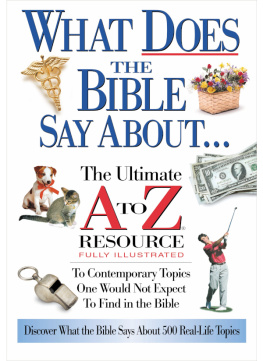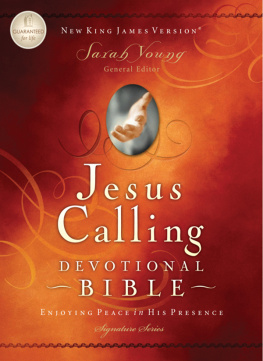
The
Holy Bible
Containing Old and New Testaments


www.ThomasNelson.com
NKJV Ministers Bible
Copyright 2018 by Thomas Nelson, a division of HarperCollins Christian Publishing, Inc.
The Holy Bible, New King James Version, copyright 1982 by Thomas Nelson.
All rights reserved.
ePub Edition February 2018: 978-0-785-21658-2
Library of Congress Control Number: 2017911775
Resources for the Minister adapted from Nelsons Ministers Manual, NKJV Edition.
The text of the New King James Version (NKJV) may be quoted or reprinted without prior written permission with the following qualifications: (1) up to and including 1,000 verses may be quoted in printed form as long as the verses quoted amount to less than 50% of a complete book of the Bible and make up less than 50% of the total work in which they are quoted; (2) all NKJV quotations must conform accurately to the NKJV text.
Any use of the NKJV text must include a proper acknowledgement as follows:
Scripture taken from the New King James Version. Copyright 1982 by Thomas Nelson. Used by permission. All rights reserved.
However, when quotations from the NKJV text are used in church bulletins, orders of service, Sunday school lessons, church newsletters, and similar works in the course of religious instruction or services at a place of worship or other religious assembly, the following notice may be used at the end of each quotation: NKJV.
For quotation requests not covered by the above guidelines, write to Thomas Nelson, Attention: Bible Rights and Permissions, P.O. Box 141000, Nashville, TN 372141000.
Information about External Hyperlinks in this ebook
Please note that this ebook may contain hyperlinks to external websites. These hyperlinks have not been activated by the publisher, who cannot verify the accuracy of these links beyond the date of publication.
Table of Contents
What is the difference between an eBook and a print book?
eBook versions of Bibles contain all the content and supplementary materials found in the original print versions and are optimized for navigation in the various apps and devices used for display. eReaders recognize text as one fluid string and are formatted in a single column, which differs from the multi-column layout seen in many print version Bibles. Therefore, some content may not match the exact appearance of the original print version, but instead uses hyperlinks to navigate between related content.
How do I use the eBook Table of Contents?
*Important Note: Be sure to consult your device manufacturers Users Guide for device-specific navigation instructions.*
The is generally formatted in the same order as the original print version and hyperlinked as follows:
To navigate to specific Bible books, chapters, or verses, please note the following:
Book links (Ex. Genesis) go directly to the Introduction of each book, or the beginning of that Bible book if there is no introductory text.
Chapter links go directly to the beginning of the chapter associated with a book.
Use the devices Next Page/Previous Page buttons or functions to scroll through the verses in each chapter.
Every Bible book and chapter hyperlink in the Bible text returns or goes back to the . Or, use the devices back button or function to go back to the last selection.
How do I navigate supplementary materials?
Footnotes (Translators Notes) are marked with small, hyperlinked superscript letters a.
Select the hyperlinked superscript letter in the main Bible text to go to the corresponding footnote.
Select the hyperlinked letter to the left of the footnote(s) and you are returned to the main Bible text, or use the devices back button or function to go back to the last selection.
are features that supplement the Bible text and are hyperlinked directly to the content-specific location following the main Bible text.
Select the hyperlinked entry in the to the specific article, list, or index.
Select the Bible reference or article hyperlink to the corresponding main Bible text or article.
Use the devices back button or function to go back to the last selection.
Purpose
In the preface to the 1611 edition, the translators of the Authorized Version, known popularly as the King James Bible, state that it was not their purpose to make a new translation... but to make a good one better. Indebted to the earlier work of William Tyndale and others, they saw their best contribution to consist in revising and enhancing the excellence of the English versions which had sprung from the Reformation of the sixteenth century. In harmony with the purpose of the King James scholars, the translators and editors of the present work have not pursued a goal of innovation. They have perceived the Holy Bible, New King James Version, as a continuation of the labors of the earlier translators, thus unlocking for todays readers the spiritual treasures found especially in the Authorized Version of the Holy Scriptures.
A Living Legacy
For more than four hundred years, and throughout several revisions of its English form, the King James Bible has been deeply revered among the English-speaking peoples of the world. The precision of translation for which it is historically renowned, and its majesty of style, have enabled that monumental version of the Word of God to become the mainspring of the religion, language, and legal foundations of our civilization.
Although the Elizabethan period and our own era share in zeal for technical advance, the former period was more aggressively devoted to classical learning. Along with this awakened concern for the classics came a flourishing companion interest in the Scriptures, an interest that was enlivened by the conviction that the manuscripts were providentially handed down and were a trustworthy record of the inspired Word of God. The King James translators were committed to producing an English Bible that would be a precise translation, and by no means a paraphrase or a broadly approximate rendering. On the one hand, the scholars were almost as familiar with the original languages of the Bible as with their native English. On the other hand, their reverence for the divine Author and His Word assured a translation of the Scriptures in which only a principle of utmost accuracy could be accepted.
In 1786 Catholic scholar Alexander Geddes said of the King James Bible, If accuracy and strictest attention to the letter of the text be supposed to constitute an excellent version, this is of all versions the most excellent. George Bernard Shaw became a literary legend in the twentieth century because of his severe and often humorous criticisms of our most cherished values. Surprisingly, however, Shaw pays the following tribute to the scholars commissioned by King James: The translation was extraordinarily well done because to the translators what they were translating was not merely a curious collection of ancient books written by different authors in different stages of culture, but the Word of God divinely revealed through His chosen and expressly inspired scribes. In this conviction they carried out their work with boundless reverence and care and achieved a beautifully artistic result. History agrees with these estimates. Therefore, while seeking to unveil the excellent
Next page





![Thomas Nelson - The NKJV Study Bible [Full-Color Edition]](/uploads/posts/book/79115/thumbs/thomas-nelson-the-nkjv-study-bible-full-color.jpg)













